THE LORDSHIP & BARONY OF KILMARNOCK
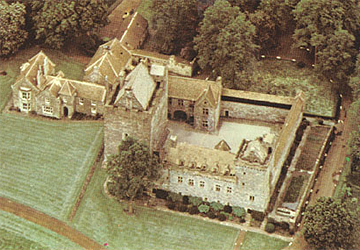
Dean Castle was known as Kilmarnock Castle until c1700. It was described by Pont in Dobie's Pont's Cuninghame, pp. 292-3:
"Killmernock Castle, it is a staitly faire ancient bulding arysing in tuo grate heigh towers and bult arround courtewayes vith fyne low buildings. It [sic] is veill planted and almost environed vith gardens, orchards, and a parke. . ."
It is a 13-14th century defensive 'keep' structure of severe architecture, located in a dean (wooded glen) at the meeting of the Borland and Craufurdland Waters (now Kilmarnock Water) about a mile north-east of Kilmarnock. To see the exact location on a map, click here - an arrow indicates the site.
The Keep, thought to contain earlier work from c.1350 - was built c.1460. A stern defence structure, the walls are 8'-9' thick and 63' high, with battlements at the top. Internally it is comfortable. Anyone keen to learn of the castle in considerable historical detail, complete with dimensioned drawings, should locate 'Archaeological and Historical Collections relating to the Counties of Ayr and Wigton Vol.III' (of which only 400 copies were printed in 1882).
The Gatehouse, with two rounded towers, loophole gun ports and half-leaded glass windows, was built 1935-36 and is similar to that at Rowallan Castle, built in 1567.
The Palace was built by Lord Boyd c.1467 when he was raised to the Peerage. The two seriously eroded coats of arms carved on the west gable are those of Princess Mary, sister of King James III, and Thomas Boyd, Earl of Arran.
In 1735 the Palace was gutted by fire and was abandoned for nearly 200 years. The estate and the castle was sold in 1748 by James Boyd, son of the Earl, to William Cunningham, 13th Earl of Glencairn. His son James, the 14th Earl of Glencairn, sold the estate to Henrietta, 'the rich Miss Scott', eldest daughter of General John Scott of Balcomie, Fife in 1786. Henrietta married the Marquis of Titchfield - later the 4th Duke of Portland - in 1795. The Kilmarnock Estate inheritance passed to Henrietta's daughters, her direct descendants.
One of her daughters, Lady Lucy Cavendish-Bentinck, married Charles Austus Ellis, the 6th Lord Howard de Walden, in 1828. When she died in 1899 her grandson and direct descendant, Thomas Evelyn Ellis, the 8th Lord Howard de Walden and 4th Lord Seaford, inherited the Kilmarnock Estate and the Castle. He added Scott to his name, becoming Thomas Evelyn Scott-Ellis. The genealogy of Lord de Walden can be seen here.
Lord Howard de Walden, with architect Henry Brown of Kilmarnock and later with Dr. James Richardson, Inspector of Ancient Monuments (and expert on Scottish historic architecture) restored the Keep by 1908 and the Palace by 1946. The 8th Lord de Walden died in November 1946, aged 66 years.
John Osmael Scott-Ellis, the 9th Lord Howard de Walden, gifted the Castle, 40 acres of land and the collection of arms, armour, tapestries and musical instruments to Kilmarnock and Loudoun District Council in 1975. The District Council purchased an additional 160 acres of land in 1976. The Castle opened as a public museum in 1976, and the Country Park development was formally opened in 1980. Lord de Walden died in 1999 at the age of 86.
Below, at rest in the Dean Castle grounds, are the graves of the 8th Lord Howard de Walden, his wife Margherita, and the angel memorial to his mother, Blanche.


Below is a HD video featuring Dean Castle and the Country Park kindly provided by Coast-TV Scotland. It is now several years old.
Below is a recent drone HD video of Dean Castle, Kilmarnock, kindly provided by Colourwheel Media, a creative company located in the Dean Castle Country Estate:
KILMARNOCK HOUSE
Kilmarnock House in St. Marnock Street, Kilmarnock (see below) became the residence of the Boyds after an accidental fire gutted Dean Castle in 1735. The house was later occupied by the Earl of Glencairn, and from 'Rambles Round Kilmarnock', "Kilmarnock House is now converted into an Industrial Ragged School, and in it many poor children who have lost their parents, and others who would otherwise become waifs of society, find a home". It then became a reform school. It was demolished in 1935, and the area is now the car park opposite St. Marnock's Church. A town plan map of Kilmarnock dated 1783 showing Kilmarnock House and land can be seen here.


THE LADY'S WALK
'The Lady's Walk' in Howard Park, Kilmarnock, commemorates the walks in grief of the young widow of the Earl of Kilmarnock (beheaded at Tower Hill, London, 1746). The Park was formerly part of the grounds of Kilmarnock House, and was given to the town in 1892 by Baroness Howard de Walden. At that time, the Kilmarnock Water flowed alongside of The Lady's Walk, and Howard Park was then known as Barbadoes Green. The Lady's Walk in the old postcard below is much different from today. It is said that the Countess died of grief the following year on 16th September, 1747.


TRIVIA
A poem 'The Lady's Walk' by Aston Carle (in Rambles Round Kilmarnock) was the influence for a words & images project by local primary school pupils. The outcome was eight engraved seat tops around trees in Howard Park, unveiled in 2010. Photographs and details can be seen here.
The lyrics of 'Lady Kilmarnock's Lament' are traditional, later to became a haunting song with a melody by Alan Reid © Kinmor Music. The recording 'Lady Kilmarnock's Lament' is on a vinyl (above, 1980) called SIDETRACKS by Alan Reid & Brian McNeill - founder members of the Battlefield Band - on the Topic Records label. This song was most kindly dedicated to Eur Ing David Ayre, 29th Baron of Kilmarnock by Alan Reid with gratitude for his appreciation.
An old newspaper clipping reporting children seeking 'The Grey Lady' (reputed to dance in the Castle gardens at midnight) can be seen here.
DIGITISED BOOK INFORMATION
1 - 'Rambles round Kilmarnock' by Archibald R. Adamson 1839 can be read on-line or downloaded as a .pdf document here.
2 - 'Dean Castle Country Park: Conservation Management Plan - 2015' can be read on-line or downloaded as a .pdf document here.
3 - 'Dean Castle And Country Park Business Plan - 2015' can be read on-line or downloaded as a .pdf document here.
 |
 |
 |
 |
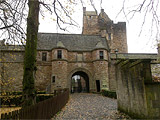 |
||
 |
 |
 |
 |
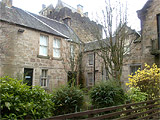 |
||
 |
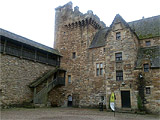 |
 |
 |
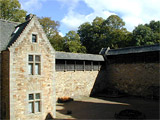 |
||
 |
 |
 |
 |
 |
||
 |
 |
 |
 |
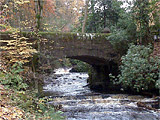 |
||
 |
 |
 |
 |
 |
||
 |
 |
 |
 |
 |
||